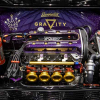It is easy to get into a sort-of tail-chasing with this.
If a higher ratio FDR is fitted there will be a loss of acceleration. This can, in turn, lead an owner to modify their engine to try to get that acceleration back. However, a hotter cam, higher compression ratio head, improved induction & exhaust system, whilst giving improved power and torque, will also mean the power and torque are produced at higher revs and with a narrower power/torque band.
This means that when changing up, the new gear may not be within the best power band and the torque may be lower than it was at those revs prior to the modifications.
In fact, when an engine is modified, the gear ratios need to be closer and a lower FDR can help with this. A modified engine will need to rev higher as well, so the lower FDR can help a lot.
With a highly modified engine a close ratio gear set may be needed. Then first gear will be much higher, so an even lower FDR will be needed.
As an example, my 1275 'S' has a straight-cut close-ratio gearbox and since max torque is at well over 420 rpm and max power is at 6400 rpm, I have to use a 3.9:1 FDR in order to get good acceleration without having to slip the clutch a lot.
Over the years I have found the 3.44:1 to be an ideal compromise with standard and mildly modified engines running standard gear ratios.





















